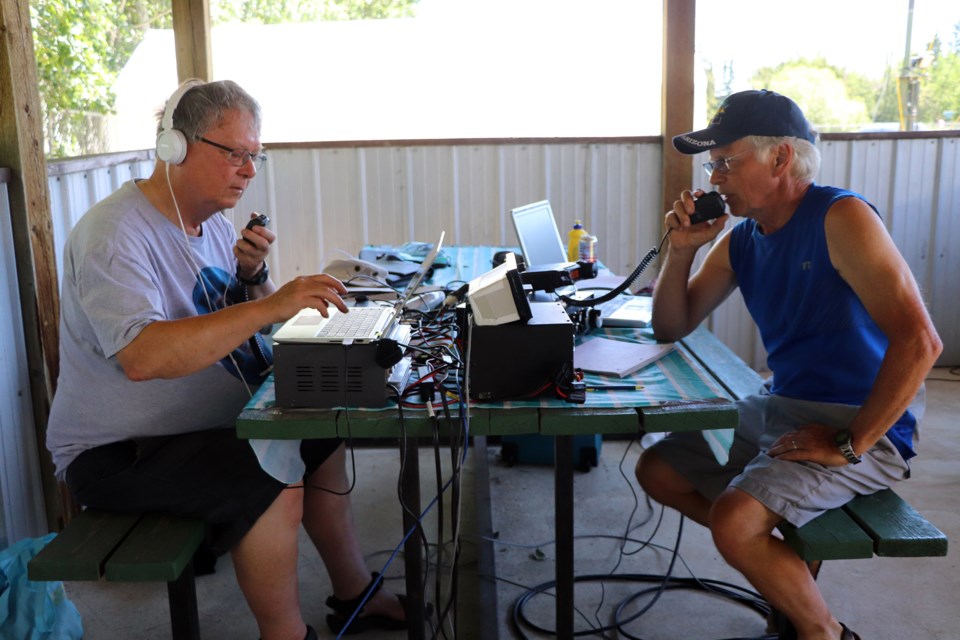BOWDEN – It was just after 7 p.m. on July 14, 2000 when Lacombe’s Bob King heard the news.
A tornado hit a Pine Lake campground. King, an amateur ham radio operator, turned his antennas south as he knew there were others in the Pine Lake area he could talk to without using a repeater.
When he found out this was a disaster in the making, he contacted other amateur ham radio operators. Over the next 24 hours more than 40 of them would play a crucial communication role that saved valuable time for emergency responders, and possibly lives.
These were the days when cell coverage was iffy at best in rural areas, and emergency responders would soon find out the few cell channels in the Pine Lake area had been inadvertently jammed up by anxious press.
However, the amateur ham radio operators expertly set themselves up to save the day by relaying critically important messages from emergency responders near the disaster area to waiting medical teams in Innisfail, Springbrook and Red Deer.
“When an official needed to pass a message, he told the amateur ham radio operator who he wanted the message to go to, and what the message was, and then we carried that message over our radio system to another amateur at the triage site at Springbrook to have their officials expecting that person,” said Brian Davies, an Innisfailian and director with the Central Alberta Amateur Radio Club (C.A.A.R.C.), which was incorporated in 1955 and now has about 50 members.
Tragically, the Pine Lake tornado claimed the lives of 12 people. However, the extraordinary contribution so many made, including C.A.A.R.C. members, was not forgotten. The efforts by amateur ham radio operators during the Pine Lake crisis led to the creation of a common commercial radio frequency for emergency services to use.
“We accomplished a whole lot out there,” he added. “I know personally the fellow that was in the emergency operations centre in Edmonton and he was so impressed by what we pulled off he became an amateur radio operator.”
Twenty-one years later both King and Davies are still amateur ham radio operators and members of C.A.A.R.C.
On June 26, they joined other club members for a weekend meet at Hillcrest Hall, about 12 kilometres west of Bowden, to take part in the annual Field Day, which has been held across the world for amateur ham radio operators since 1933, and always on the fourth full weekend of June.
Participants attempt to get as many points as possible for the club over a 24-hour period. Each club’s final results are sent in to the American Radio Relay League, which oversees these contests in North America. Clubs build up by the number of contacts they make across the area established for the contest.
They also get them for the type of power being used, and a “bonus multiplier” for ensuring the press attended.
“Because that is advertising our capability and endeavors. You are going to write a story on it and maybe somebody will become an operator because of it,” said Davies.
This year the area of coverage for Field Day was North America. By noon on June 26, the grounds of Hillcrest Hall looked almost like a high-tech military operation. Five antennas between the height of 10 to 12 metres were strategically set up across the grounds between trucks and tents with amateur ham radio operators hovering over computers to send and receive messages.
To connect with others across North America, the antennas would relay outgoing messages and catch incoming ones through a complicated system of various wavelengths - 80-metre, 40-metre and 20-metre from the high frequency band, six-metre and two-metre from the very high frequency band and 70-centimetre from the ultra high frequency band.
In another tent, things got a whole lot simpler, or at least it seemed. Innisfail’s Rod Martin was working with Morse code on a 70-centimetre band. Sometimes simple is best, even in this high-tech world.
“The object out here is to test all of this stuff, test our set up, test our take down,” said Davies. “During the contest we got people on computers logging the contacts. We make a contact, they give us their call sign; they give us a numerical value for how strong and readable our signal is because that is important to getting concise communications.”
When it was all over, club members made more than 200 contacts across North America. Total points are still being calculated. Nevertheless, Davies and his group of amateur ham radio operators not only continued a proud communications legacy of ham radio accomplishments, they continued to prove their way is still very much relevant alongside today’s constant evolving cyber innovation.
“There is a lot of stuff now being stored on the Cloud but if you lose your gigabyte connection to the Cloud you lose your data, and you can’t access it. It might as well not exist,” said Davies. “The more complex high tech the communications system is, the more fragile it is if something goes wrong.
“Our stuff is rudimentary, and it’s bullet proof.”
For more information on the Central Alberta Amateur Radio Club visit the website at www.caarc.ca



